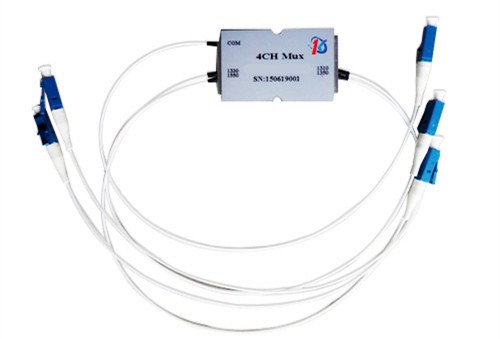Coarse Wavelength Division Multiplexing (CWDM) mux/demux is an important component in WDM systems, that is typically used to join multiple wavelengths onto a single fiber. Generally, bidirectional or dual-fiber CWDM mux/demux is used to transmit signals bi-directionally. It uses the same wavelengths for transmitting and receiving optical signals on both sides. However, bi-directional CWDM Mux/Demux is not the right choice for all applications. In some cases where there is only one wavelength or fiber available for signal transmission, you have to use single-fiber CWDM Mux/Demux.
In this post, you will learn about single-fiber CWDM Mux/Demux and how it works.
What does a single-fiber CWDM Mux/Demux mean?
Typically, a single-fiber CWDM Mux/Demux has only one simplex line port, which makes it different from a dual-fiber CWDM Mux/Demux design-wise. However, you can find some single-fiber CWDM Mux/Demux with duplex ports. Since it is a single-fiber CWDM Mux/Demux, only one port of the duplex port is used and the other is usually marked N/A.
A single-fiber CWDM Mux/Demux can also achieve dual-way transmission. In bidirectional CWDM networks, each wavelength runs in two opposite directions. On the other hand, each wavelength runs in only one direction in single-fiber CWDM Mux/Demux. But if one wants to create a dual-way transmission link between two different sites, one can use the same one wavelength over duplex fiber with dual-fiber CWDM Mux/Demux or use two wavelengths, i.e. one for the transmitter and the other for the receiver, over simplex fiber with single-fiber CWDM Mux/Demux.
How does a single-fiber CWDM Mux/Demux work?
In a CWDM network, there are 16 wavelengths that you can use to support 8 pairs of dual-way transmission. Let’s assume there are two sites, Site 1 and Site 2. An 8-channel single-fiber CWDM Mux/Demux is installed using 8 wavelengths for signal transmission and the other 8 wavelengths for receiving at Site 1. At Site 2, there is another single-fiber CWDM Mux/Demux installed. However, the wavelengths for transmission and receiving are reversed.
For example, a pair of dual-way optical signals is using 1270 nm wavelength for transmission and 1290 nm for receiving at Site 1, while, at Site 2, 1290nm is used for transmission and 1270 nm is used for receiving. That’s how, with single-fiber CWDM Mux/Demux, one can achieve dual-way transmission.
How do you find the right fiber optic transceivers for single-fiber CWDM Mux/Demux?
Since there are two different wavelengths on a duplex channel port, one can get easily confused while buying fiber optic transceivers for single-fiber CWDM Mux/Demux. The only thing you need to keep in mind is that the selection of fiber optic transceivers for single-fiber CWDM Mux/Demux mainly depends on the wavelength of transceiver/transmission. The fiber optic transceivers used for single-fiber CWDM Mux/Demux are different on the two sites.
All wavelengths in a single-fiber CWDM network go in one direction. For instance, SFP transceivers using 1470nm, 1510nm, 1550nm, and 1590nm are linked with the CWDM Mux/Demux onone side of the network. The SFP transceivers installed on the other side of the network are working on 1490nm, 1530nm, 1570nm, and 1610nm.
Thus, eight wavelengths are used for 4 pair dual-way transmission in a single-fiber CWDM network.
